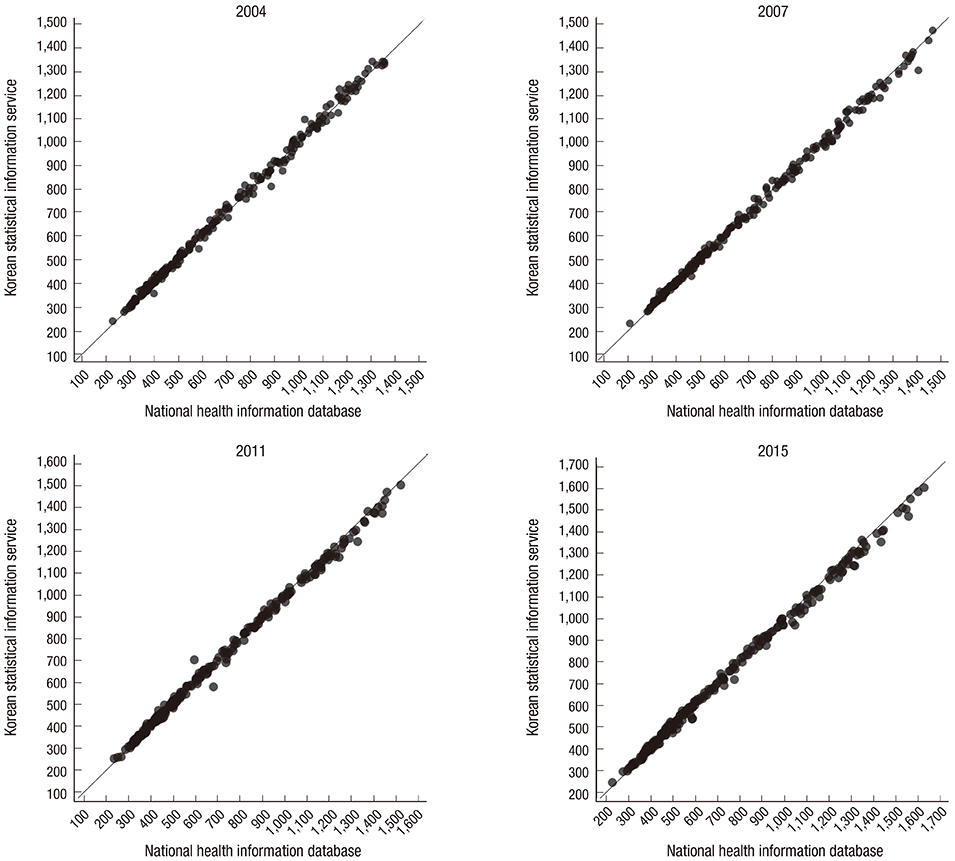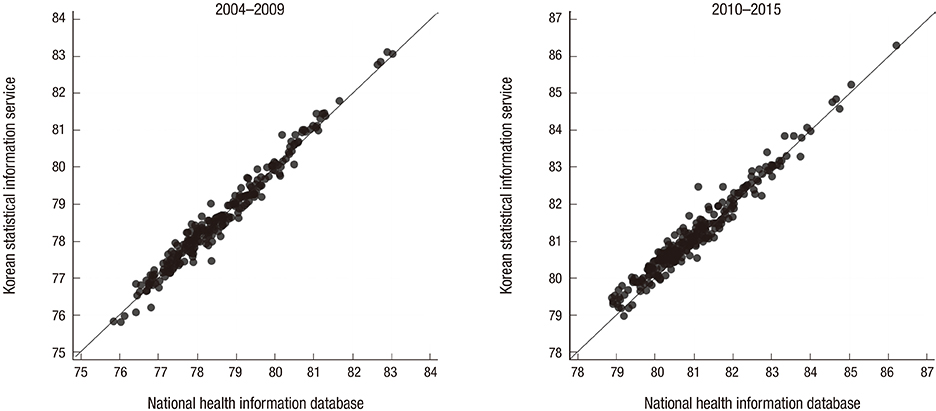Using the National Health Information Database of the National Health Insurance Service in Korea for Monitoring Mortality and Life Expectancy at National and Local Levels
- Affiliations
-
- 1Department of Public Health, Keimyung University, Daegu, Korea.
- 2Institute of Health Policy and Management, Seoul National University Medical Research Center, Seoul, Korea. yhkhang@snu.ac.kr
- 3Big Data Steering Department, National Health Insurance Service, Wonju, Korea.
- 4Department of Health Policy and Management, Seoul National University College of Medicine, Seoul, Korea.
- 5The People's Health Institute, Seoul, Korea.
- 6Department of Clinical Epidemiology and Biostatistics, University of Ulsan College of Medicine, Asan Medical Center, Seoul, Korea.
- 7Gwanak Branch Office, National Health Insurance Service, Seoul, Korea.
- KMID: 2390301
- DOI: http://doi.org/10.3346/jkms.2017.32.11.1764
Abstract
- This study explores whether the National Health Information Database (NHID) can be used to monitor health status of entire population in Korea. We calculated the crude mortality rate and life expectancy (LE) at birth across the national, provincial, and municipal levels using the NHID eligibility database from 2004 to 2015, and compared the results with the corresponding values obtained from the Korean Statistical Information Service (KOSIS) of Statistics Korea. The study results showed that the ratio of crude mortality rate between the two data was 0.99. The absolute difference between the LE of the two data was not more than 0.5 years, and did not exceed 0.3 years in gender specific results. The concordance correlation coefficients (CCC) between the crude mortality rates from NHID and the rates from KOSIS ranged 0.997-0.999 among the municipalities. For LE, the CCC between the NHID and KOSIS across the municipalities were 0.990 in 2004-2009 and 0.985 in 2010-2015 among men, and 0.952 in 2004-2009 and 0.914 in 2010-2015 among women, respectively. Overall, the NHID was a good source for monitoring mortality and LE across national, provincial, and municipal levels with the population representativeness of entire Korean population. The results of this study indicate that NHID may well contribute to the national health promotion policy as a part of the health and health equity monitoring system.
Keyword
MeSH Terms
Figure
Cited by 4 articles
-
Spatio-temporal Analysis of District-level Life Expectancy from 2004 to 2017 in Korea
Hwa-Kyung Lim, Hee-Yeon Kang, Ikhan Kim, Young-Ho Khang
J Korean Med Sci. 2020;36(2):e8. doi: 10.3346/jkms.2021.36.e8.Use of the National Health Information Database for Estimating Town-Level Mortality in Korea: Comparison with the National Administrative Data, 2014–2017
Ikhan Kim, Youngs Chang, Hee-Yeon Kang, Yeon-Yong Kim, Jong Heon Park, Young-Ho Khang
J Korean Med Sci. 2019;34(23):. doi: 10.3346/jkms.2019.34.e168.Cancer-free Life Expectancy in Small Administrative Areas in Korea and Its Associations with Regional Health Insurance Premiums
Eunjeong Noh, Hee-Yeon Kang, Jinwook Bahk, Ikhan Kim, Young-Ho Khang
J Korean Med Sci. 2021;36(42):e269. doi: 10.3346/jkms.2021.36.e269.Current Trends of Big Data Research Using the Korean National Health Information Database
Mee Kyoung Kim, Kyungdo Han, Seung-Hwan Lee
Diabetes Metab J. 2022;46(4):552-563. doi: 10.4093/dmj.2022.0193.
Reference
-
1. Seong SC, Kim YY, Khang YH, Heon Park J, Kang HJ, Lee H, Do CH, Song JS, Bang JH, Ha S, et al. Data resource profile: the National Health Information Database of the National Health Insurance Service in South Korea. Int J Epidemiol. 2017; 46:799–800.2. Chetty R, Stepner M, Abraham S, Lin S, Scuderi B, Turner N, Bergeron A, Cutler D. The association between income and life expectancy in the United States, 2001–2014. JAMA. 2016; 315:1750–1766.3. Statistics Korea. Korean Statistical Information Service [Internet]. accessed on 25 December 2016. Available at http://kosis.kr/statisticsList/statisticsList_01List.jsp?vwcd=MT_ZTITLE&parmTabId=M_01_01.4. Jonker MF, van Lenthe FJ, Congdon PD, Donkers B, Burdorf A, Mackenbach JP. Comparison of Bayesian random-effects and traditional life expectancy estimations in small-area applications. Am J Epidemiol. 2012; 176:929–937.5. Scherbov S, Ediev D. Significance of life table estimates for small populations: simulation-based study of estimation errors. Demogr Res. 2011; 24:527–550.6. Eayres D, Williams ES. Evaluation of methodologies for small area life expectancy estimation. J Epidemiol Community Health. 2004; 58:243–249.7. Wilmoth JR, Andreev K, Jdanov D, Glei DA, Boe C, Bubenheim M, Philipov D, Shkolnikov V, Vachon P. Methods protocol for the human mortality database, version 5 [Internet]. accessed on 25 December 2016. Available at http://mortality.org.8. Thatcher AR, Kannisto V, Vaupel JW. The Force of Mortality at Ages 80 to 120. Odense: Odense University Press;1998.9. Preston SH, Heuveline P, Guillot M. Demography: Measuring and Modeling Population Processes. Malden, MA: Blackwell Publishers;2001.10. Lin LI. A concordance correlation coefficient to evaluate reproducibility. Biometrics. 1989; 45:255–268.11. Khang YH, Bahk J, Yi N, Yun SC. Age- and cause-specific contributions to income difference in life expectancy at birth: findings from nationally representative data on one million South Koreans. Eur J Public Health. 2016; 26:242–248.
- Full Text Links
- Actions
-
Cited
- CITED
-
- Close
- Share
- Similar articles
-
- Inequality in Life Expectancy in Korea according to Various Categorizations of the National Health Insurance Premiums as a Marker of Income
- The Roles of the National Health Insurance Service in the Public Health Security
- Spatio-temporal Analysis of Districtlevel Life Expectancy from 2004 to 2017 in Korea
- Cancer-free Life Expectancy in Small Administrative Areas in Korea and Its Associations with Regional Health Insurance Premiums
- Introducing big data analysis using data from National Health Insurance Service



